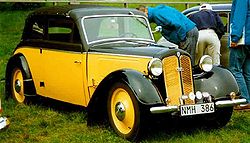DKW F7
| DKW | |
|---|---|
|
DKW Reichsklasse Limousine F7-600 (1937)
|
|
| F7 | |
| Production period: | 1937 |
| Class : | Small car |
| Body versions : | Sedan , convertible saloon , convertible , vans |
| Engines: |
Petrol engine : 0.6-0.7 liters (13.2-14.7 kW) |
| Length: | 3895-3985 mm |
| Width: | 1480 mm |
| Height: | 1440-1500 mm |
| Wheelbase : | 2610 mm |
| Empty weight : | 700-820 kg |
| Previous model | DKW F5 |
| successor | DKW F8 |
The DKW F7 is a small , front-wheel drive car from the DKW brand that Auto Union launched in 1937 as the successor to the F5 model . With 80,000 vehicles built, the F7 was the most popular DKW with front-wheel drive in the pre-war period. Like all DKW “Frontwagen” (protected name), the DKW F7 was built in the Audi factory in Zwickau . Production ended in 1939; The successor was the F8 type with a box-profile frame and an improved front axle.
The changes in appearance were minor compared to the previous F5. The simpler and less powerful “Reichsklasse” model now also had the longer body of the “Meisterklasse” . In contrast to the predecessor and the successor F8, the rear-hinged doors on both models were cut straight on the front edge. The Reich and Meisterklasse were available as a two-door sedan, convertible sedan or full convertible.
To drive the already served in the F2 master class 701 used and forward transversely mounted two-cylinder - two-stroke engine ( parallel twin ) with Schnürle - reverse circulation and two overflow channels. The motors have assisted with Reich class with 0.6 liters of capacity 18 hp, and in the master class with 0.7 liters capacity PS 20 (each at 3500 min -1 ). The front wheels were driven via a three-speed gearbox with a stick gear lever. As with the predecessor F5, the DKW-typical synthetic leather- covered plywood bodies, which were manufactured in the Berlin-Spandau plant , were placed on a stable steel central box frame . The front independent suspension on transverse leaf springs and the rear " floating axle " also remained unchanged.
In the spring of 1938, the elegant DKW F7 front luxury convertible was added to the Auto Union program, of which 2,288 cars were built. The bodies of the "Front Luxus" came from Baur in Stuttgart and were clad with sheet metal instead of artificial leather.
Technical specifications
| Type | Reich class | Master class | Front luxury cabriolet |
| Construction period | 1936-1938 | 1936-1938 | 1938 |
| Superstructures | L2, Cb2 | L2, Cb2 | Cb2 |
| engine | Two-stroke engine , two-cylinder - parallel twin | Two-stroke engine, two-cylinder parallel twin | Two-stroke engine, two-cylinder parallel twin |
| Bore × stroke | 74 mm × 68 mm | 76 mm × 76 mm | 76 mm × 76 mm |
| Displacement | 584 cc | 692 cc | 692 cc |
| Horsepower) | 18 at 3500 min -1 | 20 at 3500 min -1 | 20 at 3500 min -1 |
| Power kW) | 13.2 | 14.7 | 14.7 |
| consumption | 7 l / 100 km | 7 l / 100 km | 7 l / 100 km |
| Top speed | 80 km / h | 85 km / h | 85 km / h |
| Empty weight | 700 kg | 750 kg | 790-820 kg |
| Perm. total weight | 1020 kg | 1100 kg | 1040-1150 kg |
| Electrics | 6 volts | 6 volts | 6 volts |
| length | 3895-3985 mm | 3985 mm | 3995 mm |
| width | 1480 mm | 1480 mm | 1480 mm |
| height | 1440-1500 mm | 1440-1500 mm | 1440 mm |
| wheelbase | 2610 mm | 2610 mm | 2610 mm |
| Front / rear track | 1150 mm / 1250 mm | 1150 mm / 1250 mm | 1150 mm / 1250 mm |
| Turning circle | 12 m | 12 m | 12 m |
- L2 = two-door sedan or convertible sedan
- Cb2 = two-door convertible
source
- Werner Oswald: German Cars 1920–1945. 10th edition, Motorbuch Verlag, Stuttgart 1996, ISBN 3-87943-519-7 .
Web links
- www.audi.de - Evolution of the models: 1932–1945 DKW F 7 front luxury cabriolet four-seater, 1938





